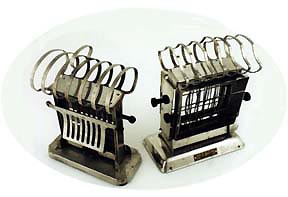|
Toast
More Durable Than Toaster And she handed over a brand new Kenwood Four Slice plastic toaster, which lasted a little longer than a year, before it stopped toasting. So, we took the Kenwood back and told the clerk at the store what happened and the clerk said -- no problem, and she handed over a new toaster -- different make, this one was a Toastronic Ultra. The following year, same problem. And same solution. We turned in the Toastronic Ultra and return it for a Kitchen Aid Toaster. Last week, the Kitchen Aid Toaster stopped toasting on one side. We took it in to the Williams-Sonoma, and the clerk handed over a Cuisinart plastic toaster. The Cuisinart toaster has all kinds of features, including a Bagel button, a defrost button, a reheat button, the now traditional lighter and darker buttons, a cancel reset button, and most annoyingly, a "shade control" panel, which in bright red lights (just what you don't want to see in the morning) tells you where exactly on a scale of very light toast to very dark toast you have calibrated your new toaster for this morning. We have a friend who is a super cautious person, but who believes that toasters should last a lifetime. (Forgive him -- he is from a different era.) So anyway, he gets one of these new plastic toasters, and the plastic lever falls off. Now everytime he wants toast, he throws caution to the wind and sticks a butter knife into the toaster's lever slot to hold down the lever until it clicks in. Annoyed at this repeated failure of modern technology, we called Williams-Sonoma's customer service line. The sales person answered and we told her our story about returning the plastic toasters periodically to her store. She said she didn't think she could do anything about the complaint. We asked -- why not just sell a toaster that lasts? And she said -- we do. It's stainless steel Dualit Combi Toaster and it sells for $319.00. The plastic Cuisinart that we just received sells for $99.95. "You can buy the Dualit and it will toast for you well into your 90s," she said with a snicker. In San Francisco, Williams-Sonoma spokesperson Tracy Brown told us that her store tries to sell the "newest and greatest" products. She said she checked with a buyer, and complaints about toasters breaking down "are not common." Brown then called back to report that "we identified reliability problems with the Kitchen Aid and that's why we got rid of it. "We really believe that the Cuisinart toaster will last," she said. Now, of course, we remember our parents' toasters -- the aluminum Toastmasters that they toasted with -- toasters that lasted a lifetime. These classic toasters had no bagel button, no defrost button, no reheat button, and definitely no shade control panel. You simply stuck the slices of bread into the slot, pushed down the lever, and waited for the toast to pop up. So, with all the wonders of modern technology, why can't the companies make a reasonably priced toaster that lasts? We put this question to Holly Smith-Berry, marketing director at the Columbia, Missouri based Toastmaster, the company that sold the first pop up toaster in 1926 (Model 1A-1) for $12.50. "We get letters from our customers, wanting to send us their old Toastmaster toasters, telling us they love the triple loop design on the side of the toaster, and they are amazed at how long they have lasted -- 50 or 60 years, in some cases," Smith-Berry said. "But if you took our 1940 steel toaster and costed it out for inflation, it would cost $170 today." She said that Toastmaster toasters today range from $10 to $30 and they are tested to last for 12 or so years. "We've seen toasters selling in Wal-Mart for $7.96," she said. "So, if you don't want to clean the crumbs out of your toaster, you can just get rid of it and buy a new one. "Unfortunately, we live in a more disposable society," she says. Toastmaster makes a heavy duty toaster, but it's built in Germany by Bosch Siemens, it's designed by Porsche, and it sells for $225. The decline of the reliable, reasonably priced toaster is symbolic of what's gone wrong with modern society -- shoddy products, disposable society, planned obsolescence, high-tech but no respect. Shade control in, quality out.'... .
|

